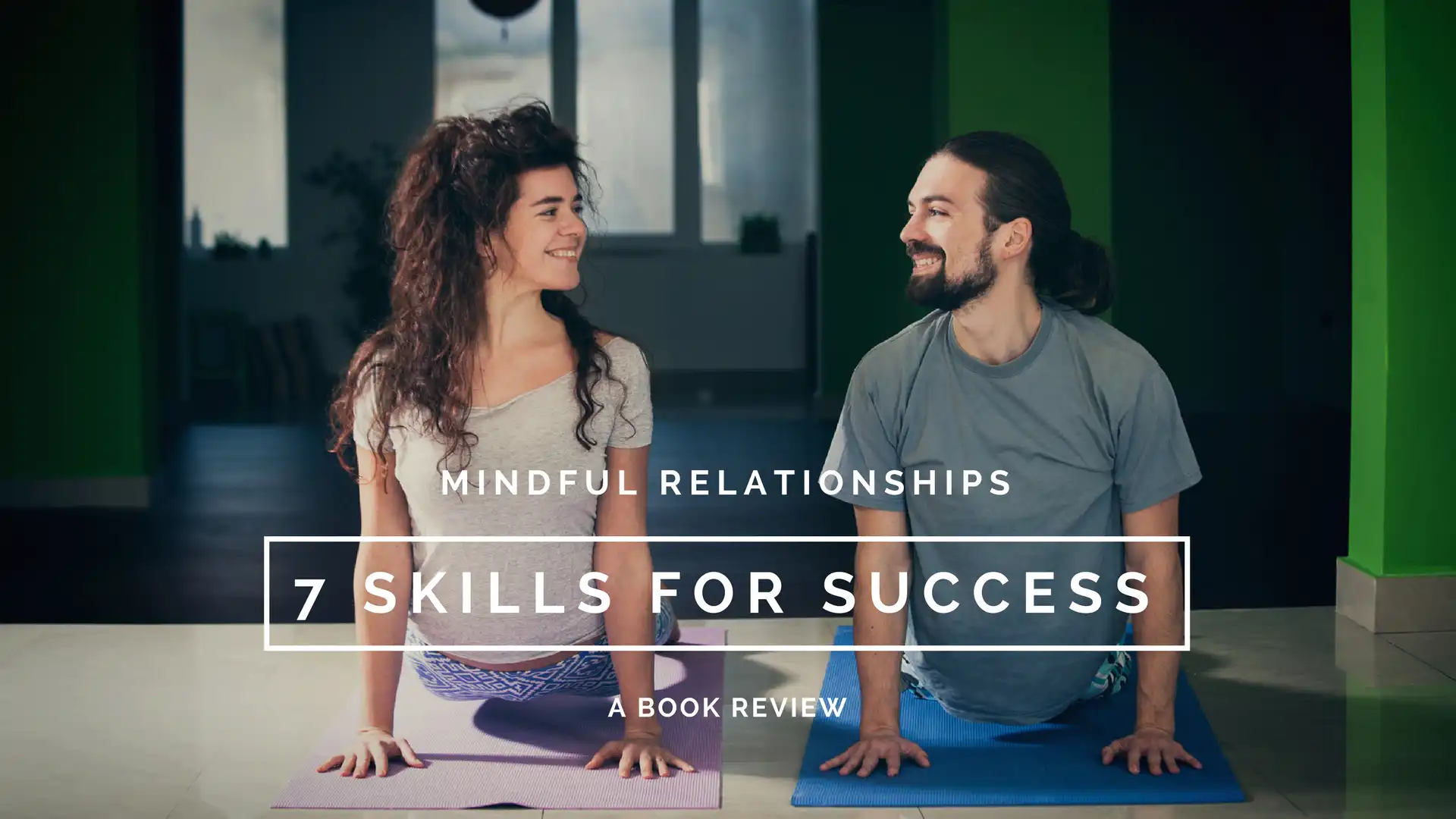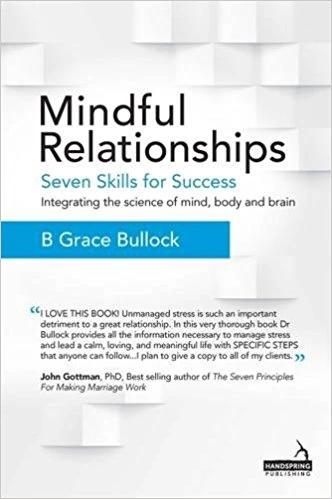Mindful Relationships: Seven Skills for Success – A Book Review

Chronic stress. We know it’s not good for us. Long-term high levels of stress have been shown to increase the risks of heart disease, systemic inflammation, autoimmune dysfunction, digestive disorders, as well as anxiety and depression. And we all know how terrible it feels to be totally stressed out for any length of time. But have you ever considered how stress negatively impacts your relationships? No? Me neither, but it makes sense when you begin to understand how our bodies and minds work when we become overwhelmed or stressed.
In her book, Mindful Relationships: Seven Skills for Success – Integrating the Science of Mind, Body and Brain, researcher, psychologist, and mind/body expert, B. Grace Bullock (Ph.D.) explains how  stress impacts and undermines our relationships, illustrating the importance of mindfulness in developing and maintaining healthy, meaningful relationships.
stress impacts and undermines our relationships, illustrating the importance of mindfulness in developing and maintaining healthy, meaningful relationships.
Weaving neuroscience, research studies, personal anecdotes, client experiences, and applicable exercises throughout, Dr. Bullock has created a comprehensive guidebook for applying mindfulness principles to our interpersonal lives, offering practical insight and useful tools for understanding and improving social connections. Her BREATHE model combines the science of mind, body, and brain to effectively relieve stress, increase self-awareness and emotional resilience, cultivate effective coping skills, and develop stable relationships.
Our Systems Under Stress
The first section of Mindful Relationships: Seven Skills for Success lays the foundation for understanding and applying Bullock’s BREATHE model presented in the second half of the book. Beginning with the importance of social bonds for our individual development and well-being, even survival, in the opening chapters Bullock scientifically explains what stress is and how it works in our bodies and brains, with the help of useful diagrams, charts, and illustrations.
“Stress” represents anything that disrupts homeostasis—our body’s ability to maintain an internal state of equilibrium in order to function efficiently. In other words, stress deregulates the systems of our mind, body, and brain interfering with our ability to communicate effectively. Advocating that knowledge is power, Bullock says that understanding how our systems work is half the solution to becoming more stress resilient.
Whenever we encounter a challenging circumstance, our bodies and brains initiate a stress response, activating the sympathetic branch of our autonomic, or involuntary, nervous system. The sympathetic nervous system is responsible for increasing heart rate, dilating pupils, narrowing bloodstream, stimulating adrenal glands, inhibiting digestion, and contracting muscles in preparation for physical exertion (“fight or flight”), all within seconds of perceived danger or excitement. Adaptive in the short term, and necessary if you’re being chased by a bear, but not sustainable or healthy for long periods of time.
Bullock describes the “bottom-up” processing that occurs in the limbic system of the brain, which is often referred to as the emotional response center, in the face of stressful or overwhelming events. Bottom-up processing filters the external sensory input we receive through the brain’s emotional circuitry first, higher order “thinking” centers second. In other words, we react without thinking or considering the outcome of our actions. Wired for survival, once the limbic system is triggered we are instantly ready for fight or flight.
Conversely, “top-down” processing is a cognitive process initiated by our thoughts, flowing down to lower level functions such as the senses—using existing knowledge, rather than emotional reactions, to help interpret our immediate circumstances. The brain’s executive system (a group of structures in the frontal cortex) is responsible for top-down mental processes, which include attention control, organizing information, planning, problem-solving, impulse regulation, and working memory. The executive system is also associated with emotional and self-regulation.
The three systems above—limbic, executive, and autonomic nervous system—are highly interconnected, continually sending and receiving millions of signals back and forth, with each system equally informing and influencing the other. Once a threat is detected (stimulating the sympathetic nervous system), the brain’s limbic system takes over, inhibiting the executive system and related cognitive functions. Conversely, when we encounter stimuli that provoke an emotional response such as anxiety and fear (triggering the limbic system), the autonomic nervous system immediately prepares us for survival, flooding us with physiological sensations like racing heart, sweaty palms, and queasy stomach.
What this means is that when we encounter stressful situations, we automatically enter into a highly aroused and reactive state (a.k.a. survival mode) that limits our higher-order mental capabilities such as verbal reasoning, problem-solving, and emotional and self-regulation. We react rather than respond, falling back on unconscious, habitual thought, and behavior patterns, and resort to survival strategies such as aggression, avoidance, or withdrawal. Essentially derailing our ability to interact skillfully.
A Case for Mindfulness
Mindfulness is the ability to stay fully present with active, open awareness, calmly observing thoughts, feelings, and bodily sensations without judgment—being with whatever is happening moment-to-moment without reacting or becoming overwhelmed by what you’re experiencing.
Mindful-based practices, which have exploded in popularity over the last decade thanks in large part to the success of Mindfulness-Based Stress Reduction (MBSR), have been proven to enhance our overall happiness and well-being. They help us become aware of our unconscious, habitual and reactive patterns—allowing us to examine our feelings, thoughts, physical sensations, perceptions, and beliefs—so that we may choose new, helpful, and adaptive responses based on our immediate circumstances.
“A state of mindfulness creates discriminant awareness, a space to consider alternative explanations, strategies, and responses to life’s circumstances rather than reacting mindlessly,” explains Bullock. “This capacity can be particularly beneficial when we are negotiating difficult or stressful terrain in our relationships.”
While the majority of mindfulness-based practices and subsequent research predominately focus on individual changes in health and well-being, Dr. Bullock points out that scientists are increasingly recognizing that “mindfulness is inherently relational, with capacities such as focused attention, awareness, nonjudgmental, and experiential acceptance being the hallmarks of good interpersonal engagement.” In fact, new research shows that mindfulness positively impacts social connectedness, is linked to greater acceptance and fewer avoidance behaviors and reduces reactivity during interpersonal conflict in romantic relationships.
Chronic Stress and Relationships
Throughout, Bullock points out the various ways stress, particularly chronic stress, negatively impacts our social bonds, drawing correlations between our minds,’ bodies,’ and brains’ response to stress and essential interpersonal skills needed for healthy, successful relationships.
Chronic stress is associated with an overactive sympathetic nervous system and near constant state of physiological hyper-arousal—wearing us down physically, emotionally, and mentally, and depleting our internal resources and reducing our ability to be mindful. Studies show that chronic stress impedes a couple’s ability to cope and that people are more likely to evaluate their relationship negatively when stressed.
She explains that the effects of chronic stress are circular. When we feel ill, unhappy, or dissatisfied in our relationships, we tend to feel more stressed. The more stressed we feel, the more likely we are to become ill and feel the strain in our relationships. We become stuck in a chronic stress feedback loop, deteriorating our relationships and our health.
Intentional Breathing
Dr. Bullock’s BREATHE Model is based on the underlying assumption that intentional breathing is the gateway to mindfulness. Taking deeper, fuller breaths is one of the fastest, most effective ways to influence the autonomic nervous system and trigger the relaxation response, helping to diffuse emotional reactivity and become present in the moment.
Breath awareness is the greatest tool we have for heading off the stress response. Detailing the mechanics of breathing, Bullock illustrates how our emotional state impacts the quality of our breath, and how the depth and rhythm of our breathing patterns can influence our emotions. By observing our breath, we can quickly tap into our physiological experience of stress or our emotional state, and decide how we choose to respond. In other words, we can use our breath to help quiet our minds and calm ourselves down enough to become aware of what we are feeling and experiencing in the moment.
The second part of intentional breathing is somatic awareness, becoming familiar with the bodily sensations that alert you that the sympathetic nervous system has taken over and that the limbic system (a.k.a. emotional brain) is governing behavior. “Breathing gives you the space to recognize the bodily sensations that arise in response to particular emotions, and empowers you to make a choice whether to act on these emotions or choose a different course,” Bullock attests.
BREATHE Model
Along with intentional breathing and somatic awareness, the BREATHE model also emphasizes the necessity of re-examining our personal stories and the many ways they shape and understand our beliefs, perceptions, and behaviors—allowing us to appraise, accept, challenge, or refute them, rather than being ruled by them. The BREATHE model invites us to adjust our mindsets and empowers us to rewrite our personal stories.
The Seven Skills of BREATHE are practical and accessible tools for bringing more mindfulness into your relationships with others, as well as yourself. They include breath awareness; intentional breathing to regulate the autonomic nervous system; allowing and experiencing emotions; appraising your mindset and personal story; taking purposeful pauses; humor, kindness, and compassion; and, engaging others differently (responding thoughtfully rather than reacting emotionally).
Another key assumption of the BREATHE model is that mindfulness is a practice. Bullock emphasizes commitment to self-care, taking time out (a purposeful pause) to breathe, rest, and engage in self-reflection during less stressful times in your life; practicing and developing mindfulness skills such as intentional breathing, body awareness, and thought appraisal, so that they are already in place and at your disposal when you need truly them. She also reminds us of the power of humor and the necessity for compassion and kindness as you make your way to more mindful living and relationships.
Overall, Bullock presents a thorough, smart and loving guidebook to bringing mindfulness into our relationships while ultimately improving the quality of our lives. An incredibly rich source of information backed by scientific evidence, and illustrated by first and second hand accounts, covering every neurological, biochemical, mental and emotional response to stress, and how it affects our perceptions, behaviors, and social bonds, this is a must read for counselors, group leaders and organizers, mindfulness professionals and anyone interested in the science of mindfulness. Understanding the systems of our brains and bodies, being able to recognize the first symptoms of stress, and being aware of the many ways stress interferes with our relationship with others, Bullock empowers readers to take charge of their lives—offering practical, simple and accessible techniques for improving our relationships with others as well as ourselves.
If you’d like more information on improving relationships study with YogaUOnline and B Grace Bullock – BREATHE: Yogic Tools for Happy, Healthy and Fulfilling Relationships.

B Grace Bullock, Ph.D., E-RYT 500 is a psychologist, research scientist, educator, yoga and mindfulness expert and author of Mindful Relationships: Seven Skills for Success – Integrating the Science of Mind, Body and Brain. Her mission is to reduce stress, increase health and well-being and improve the quality of relationships. She offers classes, workshops, writing and research that combine the wisdom of applied neuroscience, psychophysiology, psychology and contemplative science and practice. Her goal is to empower individuals, groups, leaders, and organizations to reduce chronic stress and increase awareness, attention, compassion, mindfulness and effective communication to strengthen relationships, release dysfunctional patterns and unlock new and healthy ways of being. Dr. Bullock is also the Founding Director and Principal Consultant of the International Science & Education Alliance, an organization devoted to exceptional research, program evaluation, assessment design, strategic planning, and capacity building to support equity, programmatic diversity and scientific integrity, and promote effective leadership, decision-making, and social change. Bullock is a Certified Viniyoga Therapist and Faculty at the Integrated Health Yoga Therapy (IHYT) Training program. She is the former Senior Research Scientist at the Mind & Life Institute and former Editor-in-Chief of the International Journal of Yoga Therapy. For more information see www.bgracebullock.com.

Meagan McCrary is an experienced yoga teacher (E-RYT 500) and writer with a passion for helping people find more comfort, clarity, compassion, and joy on the mat and in their lives. She is the author of Pick Your Yoga Practice: Exploring and Understanding Different Styles of Yoga, a comprehensive encyclopedia of prominent yoga styles, including each system’s teaching methodology, elements of practice, philosophical and spiritual underpinnings, class structure, physical exertion and personal attention. Currently living in Los Angeles, Meagan teaches at the various Equinox Sports Clubs, works privately with clients and leads retreats internationally. You can find her blog, teaching schedule, and latest offerings at www.MeaganMcCrary.com.



